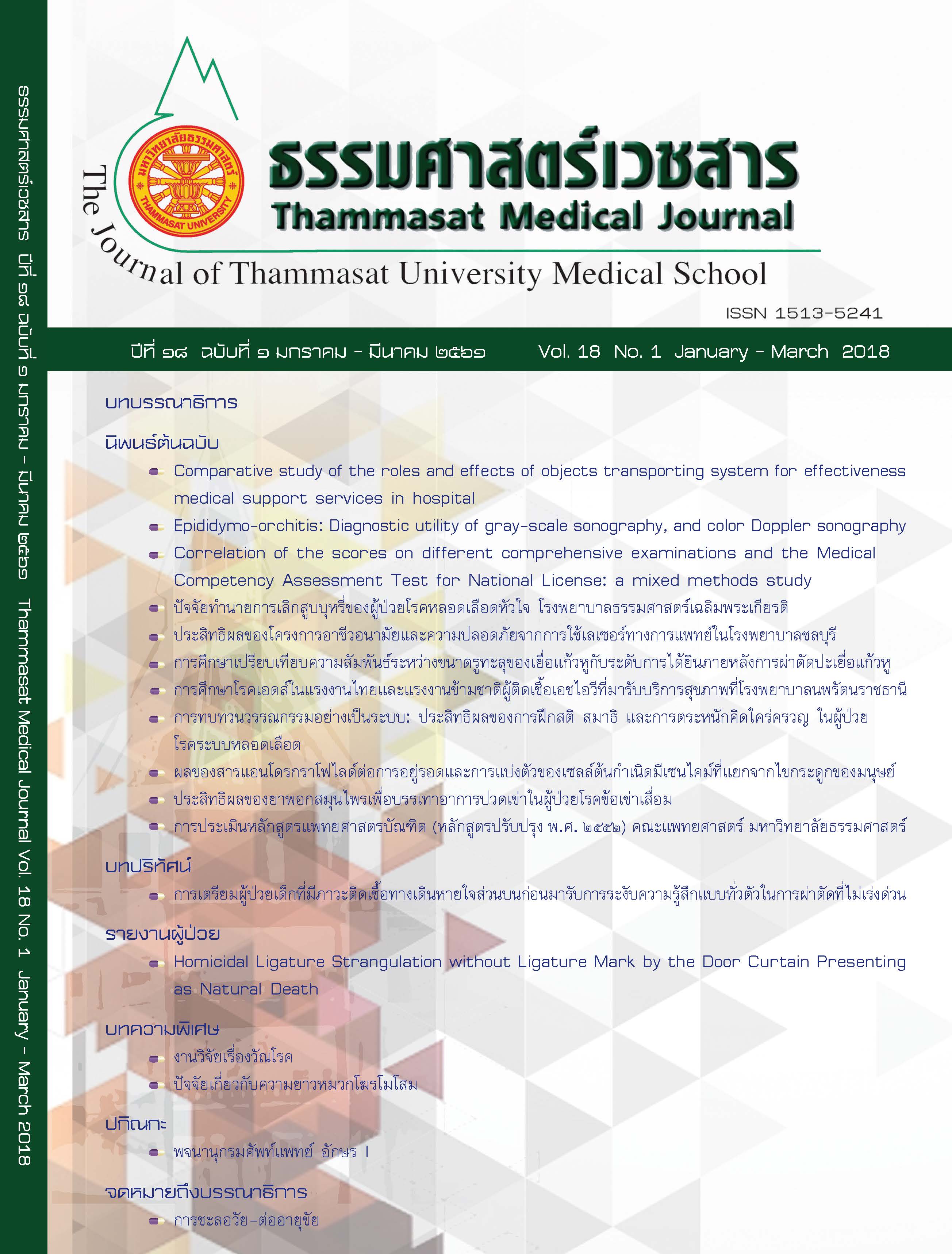Predicting factors of smoking cessation among patients with coronary artery disease at Thammasat University Hospital
Keywords:
Predicting factor, Smoking cessation, Coronary artery disease, ปัจจัยทำนาย, การเลิกสูบบุหรี่, โรคหลอดเลือดหัวใจAbstract
Introduction: Smoking is a major cause of coronary heart diseases. If the patient is still smoking, it may cause serious symptoms. The purposes of this research were to study the predictive power of attitudes about smoking, social support, perceived efficacy in smoking cessation and anxiety/depression on smoking cessation in patients with coronary artery disease.
Method: The samples were coronary heart disease patients in both genders; aged over 15 years who underwent to the surgical, medical departments, and Thammasat heart center at Thammasat University Hospital between August 2013 to March 2014, 120 samples were selected purposively. Research instruments were self-reported questionnaires including; (1) the Demographic (2) Attitude, (3) The ENRICHD Social Support Questionnaire, (4) The perceived self-efficacy questionnaire, and (5) The Hospital Anxiety and Depression Scale. The content validity index was 1.0, 1.0, 0.8 and 1.0 respectively; for the reliability was 0.85, 0.92, 0.90, and 0.86, respectively. Data were analyzed using descriptive statistics, Pearson’s product moment correlation and logistic regression.
Result: The results showed that 58.3 percent of the sample could quit smoking continued during last 1 month; attitudes about smoking, anxiety and depression were negatively associated with smoking cessation (r = -0.709, -0.479 and -0.772 respectively, p < 0.05). Social support and self-efficacy were positively related to smoking cessation (r = 0.573, 0.733 respectively, p < 0.05). Those variables can predict smoking cessation of patients with coronary artery disease by 63.5 percent (R2 = 0.635, p < 0.05)
Discussion and Conclusion: The results of this study can be applied in creating clinical practice guidelines to promote smoking cessation in patients with coronary heart disease such as family members involved in promoting smoking cessation, enhancing the perceived efficacy in smoking cessation to prevent complications and reduce the severity of the disease.
บทคัดย่อ
บทนำ: การสูบบุหรี่เป็นสาเหตุสำคัญของการเกิดโรคหลอดเลือดหัวใจ หากผู้ป่วยโรคหลอดเลือดหัวใจยังคงสูบบุหรี่ต่อไปอาจทำให้อาการของโรคทรุดลงได้ การศึกษานี้มีวัตถุประสงค์เพื่อศึกษาอำนาจในการทำนายของทัศนคติเกี่ยวกับการสูบบุหรี่ การสนับสนุนทางสังคม การรับรู้สมรรถนะแห่งตนในการเลิกสูบบุหรี่ และความวิตกกังวล/ภาวะซึมเศร้ากับการเลิกสูบบุหรี่ของผู้ป่วยโรคหลอดเลือดหัวใจ
วิธีการศึกษา: เป็นการศึกษาสหสัมพันธ์เชิงทำนาย กลุ่มตัวอย่างเป็นผู้ป่วยโรคหลอดเลือดหัวใจ ทั้งเพศชายและหญิง อายุ ๑๕ ปีขึ้นไป ที่มารับการตรวจรักษาที่หน่วยตรวจศัลยกรรม อายุรกรรม และศูนย์หัวใจ โรงพยาบาลธรรมศาสตร์เฉลิมพระเกียรติ เก็บข้อมูลระหว่างเดือนสิงหาคม พ.ศ. ๒๕๕๖ - เดือนมีนาคม พ.ศ. ๒๕๕๗ จำนวน ๑๒๐ คน คัดเลือกแบบเฉพาะเจาะจง เครื่องมือที่ใช้ คือ แบบสอบถามข้อมูลส่วนบุคคลและข้อมูลการสูบบุหรี่ ทัศนคติเกี่ยวกับการสูบบุหรี่ การสนับสนุนทางสังคม การรับรู้สมรรถนะแห่งตนในการเลิกสูบบุหรี่ และความวิตกกังวล/ภาวะซึมเศร้า ค่าดัชนีความตรงตามเนื้อหา เท่ากับ ๑.๐, ๑.๐, ๐.๘ และ ๑.๐ ตามลำดับ หาค่าความเที่ยงได้เท่ากับ ๐.๘๕, ๐.๙๒, ๐.๙๐, และ ๐.๘๖ ตามลำดับ วิเคราะห์ข้อมูลโดยใช้สถิติความถี่ ร้อยละ ค่าเฉลี่ย ส่วนเบี่ยงเบนมาตรฐาน สหสัมพันธ์เพียร์สัน และการวิเคราะห์ถดถอยโลจิสติก
ผลการศึกษา: กลุ่มตัวอย่าง ร้อยละ ๕๘.๓ สามารถเลิกสูบบุหรี่ได้ อย่างต่อเนื่องในช่วง ๑ เดือน ทัศนคติเกี่ยวกับการสูบบุหรี่ ความวิตกกังวล และภาวะซึมเศร้ามีความสัมพันธ์ทางลบกับการเลิกสูบบุหรี่ของผู้ป่วยโรคหลอดเลือดหัวใจ (r = -๐.๗๐๙, -๐.๔๗๙ และ -๐.๗๗๒ ตามลำดับ, p < ๐.๐๕) การสนับสนุนทางสังคม และการรับรู้สมรรถนะแห่งตนในการเลิกสูบบุหรี่มีความสัมพันธ์ทางบวกกับการเลิกสูบบุหรี่ของผู้ป่วย โรคหลอดเลือดหัวใจ (r = ๐.๕๗๓ และ ๐.๗๓๓ ตามลำดับ, p < ๐.๐๕) และตัวแปรดังกล่าวสามารถร่วมทำนายการเลิกสูบบุหรี่ของผู้ป่วยโรคหลอดเลือดหัวใจได้ ร้อยละ ๖๓.๕ (R2 = ๐.๖๓๕, p < ๐.๐๕)
วิจารณ์ และสรุปผลการศึกษา: ผลการศึกษาครั้งนี้สามารถนำไปจัดกิจกรรม หรือสร้างแนวปฏิบัติทางคลินิกในการส่งเสริมการเลิกสูบบุหรี่ของผู้ป่วยโรคหลอดเลือดหัวใจ เช่น การให้ครอบครัวหรือบุคคลใกล้ชิดมีส่วนร่วมในการส่งเสริมการเลิกสูบบุหรี่ การเสริมสร้างการรับรู้สมรรถนะแห่งตนในการเลิกสูบบุหรี่ เป็นต้น เพื่อป้องกันการเกิดภาวะแทรกซ้อนและลดความรุนแรงของโรคได้


